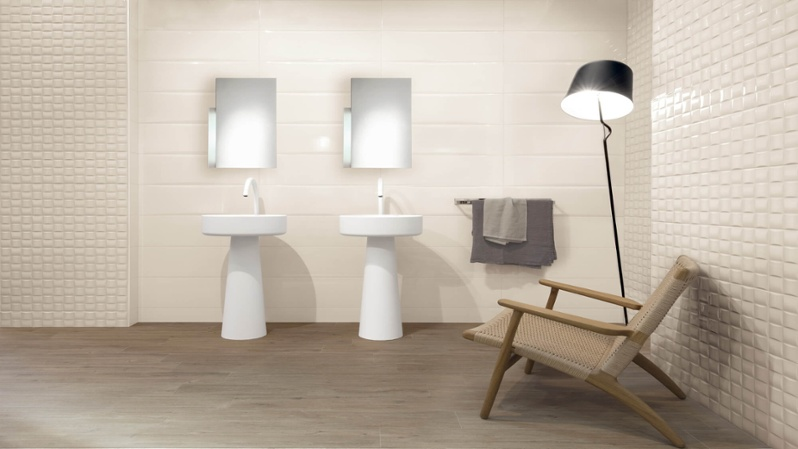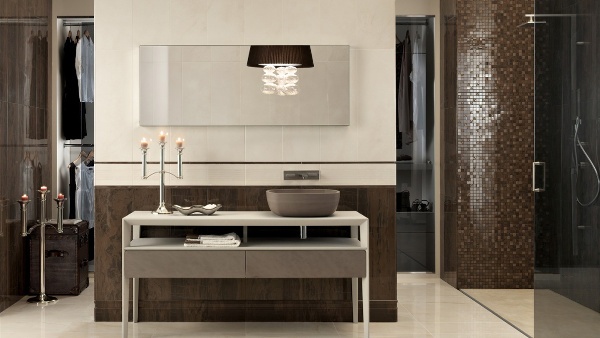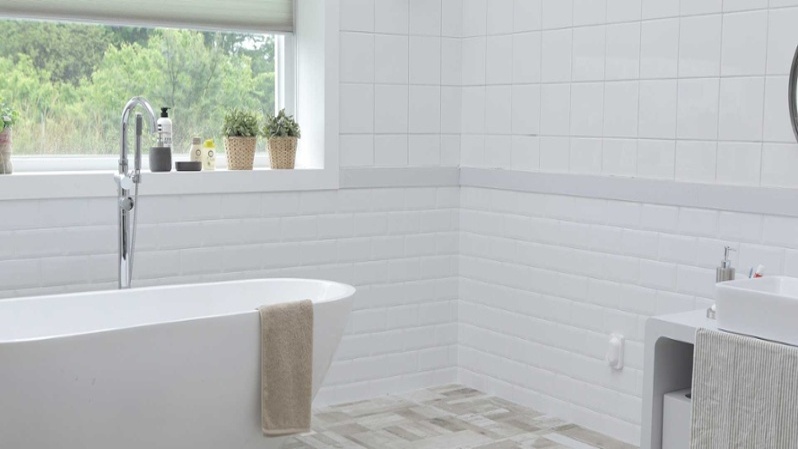
Are you planning to renovate your bathroom and do you need any idea, suggestion or advice? First of all, please take a look at our previous article.
Today we will tell you how to choose the tiles for your bathroom, not only the main difference between floor and wall coverings, but also some essential factors such as shapes, sizes, typologies and colours.
How to choose the right ones for you?
Let's start by saying that floor tiles have to be particularly resistant to wear, impact, footsteps and time. On the contrary, those made for the vertical walls are generally less durable, but often characterized by particular aesthetic effects that make them real design elements.
It is obvious that floor tiles can also be used for floor and vertical surfaces, but the opposite is impossible!
There are further distinctions and details to consider about the tiles to choose for your bathroom. Let's start with their thickness and shape. Typically, commercial tiles have a variable thickness between 5 and 15 millimetres, and are made up of different materials. If in the past tiles were almost always square or rectangular, the modern and contemporary designs also include more original shapes, such as hexagonal tiles.
Choice of tiles: the PEI index
One factor to consider when choosing your bathroom tiles is the PEI index which identifies the resistance to abrasion of the tile, which inevitably comes into contact with shoes, machinery, furniture, household appliances and cleaning products. Abrasion involves not only altering the aesthetic features of the tile, resulting in loss of shine and colour variation, but also surface removal of the materials and therefore the actual "consumption" of the product. How to choose the best, then? By checking the tile PEI index you want to buy, ranging from a minimum of 0 for less durable tiles up to a maximum of 5 for the more "tough" and durable tiles.
Summing up, then:
- PEI 0: the floor use of these tiles is absolutely discouraged
- PEI 1: they can be applied in light traffic areas only with soft sole or barefoot
- PEI 2: they are functional for floors subject to medium traffic areas, with clean or not very dirty shoes
- PEI 3: they can be installed everywhere in the house
- PEI 4: they are suggested for all residential and commercial floors with normal traffic areas
- PEI 5: they are suggested for any type of environment, including heavy traffic areas such as supermarkets
Our advice? Never choose tiles with a PEI less than 2 if you want your floor to stay in good condition for a long time!
Another factor you should consider is the resistance to slipping of the bathroom tiles.
It is an important feature that involves your personal security, and therefore should not be underestimated. A slippery floor should never be installed in your bathroom.
Always remember that there is an "R" rating that classifies the tiles according to the specific needs of their use: from R9 to R13. R9 is related to floors that have passed the first level of test, while R13 is related to commercial or industrial structures. Orientally, you can choose R9 tiles for all your bathroom interior floors and, in general, R10 or R11 tiles for any outside areas.
Choose the tiles by material or type of firing
If the choice of your bathroom tiles depends on the material or the type of firing, here is some information to keep in mind.
First of all, a few words about the ceramic tiles: beautiful and durable, they still represent the first choice for both floors and bath coverings. Today, they are among the most valued products in terms of effect, finishes, shapes, colours and textures and can be of high quality. As well as functional furnishings, ceramic tiles have undeniable technical properties such as practicality, endurance, versatility, non-toxicity and recyclability.
The term "ceramics" means only the result of the mixture of different raw materials, worked and then fired in special ovens. There are naturally different typologies, each with its peculiarities depending on materials, processing and firing time. Here are the main ones:
Terracotta tiles can be, depending on the clay composition, white or red. In the latter case, the tonality is given by the oxidation of the iron traces.
The so-called single fired tiles identifies the firing and glaze of tiles in a single operation, in special ovens with temperatures ranging from 1170 to 1200 degrees. Generally, these are not high quality tiles and are often used for low cost installations.
Otherwise, double firing operation provides that the tile is made in two phases: in the first phase, the dough is partially fired, giving rise to the so-called "biscuit", while in the second stage the product is painted with glaze and fired again.
Full body porcelain stoneware tiles are not glazed and are obtained by pressing. They can be produced in various colours and finishes depending on the materials used to make up the dough and are characterized by a very low water absorption rate of 0.04%. Porcelain stoneware tiles are almost unabsorbable, and therefore very popular for naturally damp environments such as bathrooms.
We then go to the glazed porcelain stoneware: it gives life to really high quality glazed tiles, which represent one of the latest technological evolutions in the industry. These tiles have different colours and textures and have a decorative function of the environments.
Choose bathroom tiles: dimensions, shapes and colours to make the difference
We conclude our excursus on bathroom tiles offering you some suggestions about the optimal solutions for this private and intimate environment. Assuming that ceramic tiles are made in many sizes and shapes, you should remember that they can really lead to the creation of refined and beautiful bathrooms.
From modern styles to retro and vintage designs, from country lines to minimalist shapes, enhanced by the clear colours and perhaps by the transparency of glass, from mosaics to ultra-thin tiles to form continuous surfaces with almost no joints, the possibilities are practically endless.
Here's some general advice:
- Use bicolor to lighten the environment visually. The bathroom does not necessarily have to be a monochrome environment. Instead, you can choose different shades of the same colour to visually lighten an environment characterized by a particular uniformity. And if two tones still look very rigorous, consider inserting tone on tone decorations to change the tonality and give a sense of movement.
- If your shower area is not particularly large, consider the possibility of covering it with mosaic tiles to make the net cuts of the various micro-environments of the bathroom less visible.
- Choose neutral and delicate colour tones if the bathroom is small! Remember that brightness improves the visual effect of the environment, which is perceived as wider. So choose the delicate beige tones and perhaps some central coloured bands to change the shade, and alternate shiny and opaque surfaces.
- If you love retro style, always remember that it does not have to look old! You can opt for floors and wall tiles with soft lines and pastel colours, perhaps with a panelled effect, and you can have your sanitary ware with the same style. However, our advice is to revise them in a contemporary way, so as to guarantee the environment both the elegance of the past and the most modern performance.
- If you wish to dare prefer the natural effect of the stone, but without overdo or your bathroom will seem small and suffocating. How to compensate? In addition to the lightness and brightness of the natural light points, use full-length mirrors that widen the visual perception of spaces and create uniformity between interior and exterior. You will feel like you are almost in the middle of nature.
- One last tip: do not choose excessively dark colours, unless the space available is really large and you can alternate them with different colours, shapes and finishing.
Are you ready to renovate your bathroom after taking a look at our tips?
Discover the selection of the beautiful Gardenia Orchidea ceramics that we thought for you, also by Versace.



